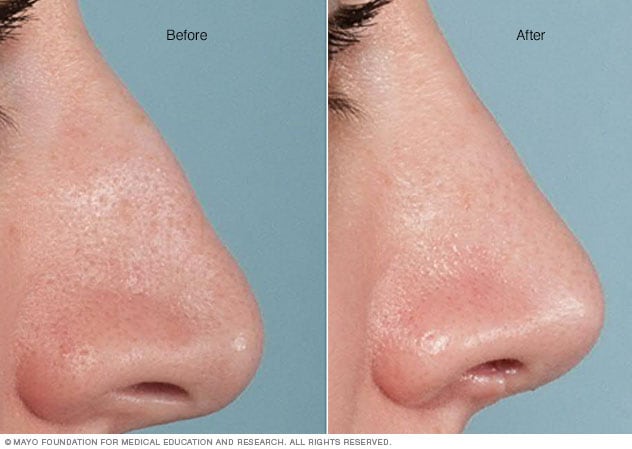- How To Crack Your Nose Back Into Place Settings
- How To Crack Your Nose Back Into Place
- How To Crack Your Nose Back Into Place Setting Aside
- How To Crack Your Nose Back Into Place Setting Meaning
- How To Crack Your Nose Back Into Place Setting Tool
Use your index fingers to press the sides of your nose, and breathe out with force. Apply pressure on the bottom of the sides of your nostrils for best results. Make sure you do not breathe out with too much force. Repeat this exercise 10 times. Place the mouthpiece in your mouth. Keep your lips firm around the mouthpiece so that all of the medicine goes into your lungs. Breathe through your mouth until all the medicine is used. This takes 10 to 15 minutes. If needed, use a nose clip so that you breathe only through your mouth. Small children usually do better if they wear a mask.
The new European data protection law requires us to inform you of the following before you use our website:
We use cookies and other technologies to customize your experience, perform analytics and deliver personalized advertising on our sites, apps and newsletters and across the Internet based on your interests. By clicking “I agree” below, you consent to the use by us and our third-party partners of cookies and data gathered from your use of our platforms. See our Privacy Policy and Third Party Partners to learn more about the use of data and your rights. You also agree to our Terms of Service.
Back cracking can occur whenever the spine’s facet joints are manipulated out of or into their normal position, such as when twisting the lower back or neck. When the facet joints move like this, they can produce an audible crack or pop along with a grinding sensation or sudden relief of pressure.
The cracking, popping, snapping, or grinding sensation that occurs when a joint moves is called crepitus and is usually a harmeless occurrence. Watch:Video: Why Do My Joints Crack?
There are two facet joints at each level of the spine, one on the right and the other on the left side. Each facet joint consists of a bony protrusion from the upper and lower vertebrae that are connected together by synovium and a network of ligaments.
Watch Facet Joint Anatomy Animation
Back cracking, also called crepitus, is a common occurrence that differs slightly for everyone. Cracking the facet joints is typically not painful or cause for concern.
Possible Causes of Cracking Spinal Joints

There is no consensus on what causes joints to crack or on the potential long-term effects of frequent back cracking. The mechanisms that cause joints to crack or grind can differ from person to person. There are three primary theories about why facet joints crack, pop, or grind:
- Cavitation. Surrounding each facet joint is a capsule of liquid, called synovial fluid, that lubricates the joints and allows for smooth, comfortable movements. One theory on crepitus suggests that air pressure within the joint is suddenly altered when the joint is cracked, resulting in the formation or collapse of an air cavity in the synovial fluid that produces a popping sound.1
- Ligament or tendon snapping. When a tight or tense ligament is pulled across a surface of bone, cartilage, or another tendon or ligament, it can create a snapping noise similar to a joint crack or pop.
- Bone grinding. Deteriorated cartilage surrounding a spinal joint can cause popping, cracking, or grinding. Cartilage may wear down from overuse and/or age, causing the bones of the joint to rub together and produce a grinding sensation and a sound similar to a crack or pop.
After a joint is cracked, it can take about 20 minutes for it to be able to crack again. It is thought that during this refractory period, the joint needs to “reset,” or return to its previous position and pressure. Forcing the joint to crack again as it resets is not advised, as doing so can push the joint past its comfortable range and strain the surrounding ligaments.
Impact of Back Cracking on The Spine
The exact mechanics of facet joint cracking and its possible effects are not fully understood. The effects of joint cracking likely vary due to individual differences in overall muscle and joint function. As a general rule, cracking the spinal joints does not cause pain or necessitate medical attention.
Back Cracking and Back Pain Relief

Cracking the facet joints is known to provide temporary relief from low back stiffness or joint pressure. More research is needed to identify any long-term benefits of back cracking.
Manual manipulation, a common method of back and neck pain relief, may focus on adjusting the facet joints to provide a healing environment and reduce pain. These adjustments may create a cracking sound.
Medical literature suggests that manual manipulation of the facet joints can contribute to decreased stiffness, improved range of motion, and a temporary reduction in pain.2 Manual manipulation, also called spinal adjustments, is commonly provided by chiropractors and osteopathic physicians.
See Chiropractic Adjustment


When Back Cracking Warrants Medical Attention
If back cracking is paired with troubling or painful symptoms, it may indicate a structural or degenerative problem with the joint. If the following occurs with facet joint cracking, medical attention may be warranted:
How To Crack Your Nose Back Into Place Settings
- Stinging, throbbing pain. Pain that feels sharp, stabbing, hot, or throbbing can sometimes occur when a joint is cracked. In the spine, this pain may indicate that a joint is pinching or irritating a nerve root.
- Consistent cracking. A joint that consistently cracks, pops, or grinds when moved can be a sign of joint dysfunction. Possible causes of consistent joint cracking and grinding include a damaged ligament or cartilage, deteriorated synovial capsule, and/or bone to bone grinding from osteoarthritis or other causes.
- Locking joint. If one of the spinal joints feels like it sticks or locks in place with certain movements, the joint structures may be deteriorated.
- Recent injury. If a noticeable change in joint cracking occurs after a trauma or injury, medical attention is typically advised to ensure that a structural change (such as a minor fracture or torn ligament) is not disrupting joint function.

If any of the above symptoms, or other concerning symptoms, are present it is advisable to consult a physician for diagnosis and treatment.
How To Crack Your Nose Back Into Place
There is little consensus regarding the long-term implications of habitual joint cracking. It is thought that when a joint is repeatedly cracked, it is consistently pulled out of its natural position, which may cause the ligaments around the joint to loosen over time. Currently there is no known correlation with joint cracking and degenerative changes.
How To Crack Your Nose Back Into Place Setting Aside
References
How To Crack Your Nose Back Into Place Setting Meaning
- 1.Kawchuk GN, Fryer J, Jaremko JL, Zeng H, Rowe L, Thompson R. Real-time visualization of joint cavitation. PLoS ONE. 2015;10(4):e0119470.
- 2.Furlan A, Tazdi F, Tsertsvadze A, et al. Complementary and Alternative Therapies for Back Pain II. Evidence Report/Technology Assessment No. 194. AHRQ Publication No. 10(11) E007. Rockville, MD; Agency for Healthcare Research and Quality. October 2010. Accessed February 3, 2017.